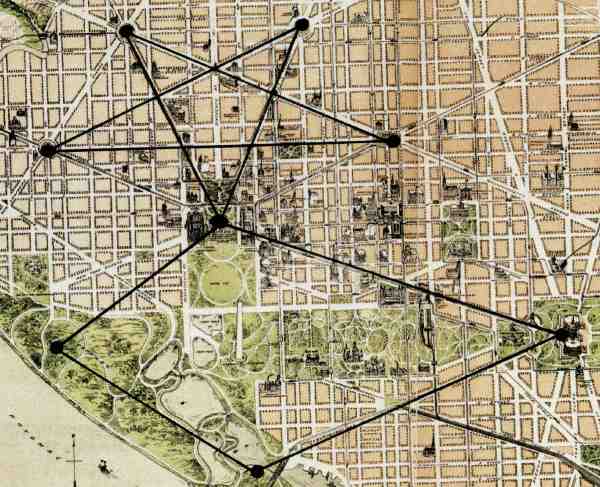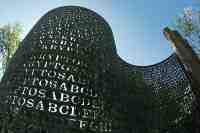




The Washingtonian - Capital Comment
http://www.washingtonian.com/blogs/capitalcomment/washingtonian/the-lost-symbol-dan-browns-pentagram-city.php#
The Lost Symbol: Dan Brown’s Pentagram City
Dan Brown’s new book—set in Washington, and coming out today—is expected to feature another secret society with an elaborate history and illustrious membership: the Freemasons.
September 15, 2009
By Sophie Gilbert

Dan Brown’s new book features a hidden Washington—does the city’s design conceal strange secrets?
Conspiracy theorists are awaiting Dan Brown’s new book, The Lost Symbol. Building on his super-bestsellers The Da Vinci Code and Angels and Demons, about conspiratorial elements of the Catholic Church, Brown’s latest—set in Washington—is expected to feature another secret society with an elaborate history and illustrious membership: the Freemasons.
As a May 2006 Washingtonian article explored, the Washington area has a deep, rich history with the Masons. (To read the article, go to washingtonian.com/masons.) As the new book’s release approaches, Brown fans have been looking for hints to the plot—and some have been released on The Lost Symbol’s Twitter feed. Here’s what might come up in the novel:

|
You don’t need to burn shoe leather looking for Masonic symbols in the nation’s capital—all you need are Google Maps and a Sharpie marker. It’s no secret that George Washington was a Freemason, but what about Pierre L’Enfant, the architect of DC? The layout of the city’s streets and landmarks seems to suggest as much—triangles and pentagrams abound.
Occult theorists have speculated that the six points of Dupont Circle, Logan Circle, Scott Circle, Washington Circle, Mount Vernon Square, and the White House form a pentagram (the five points of the outer star and one vertex of the pentagon inside it); the coordinates of the six places were recently posted as a clue on Twitter. Dupont, Scott, and Washington circles all have six major streets leading into them, encoding the satanic number 666 into the city’s structure.
That may sound sinister, but the pentagram is an ancient symbol occurring in the three major religions as well as a prominent Masonic feature. In the 2006 article, authors Paul Dickson and Thomas B. Allen also noted that the four points of the White House, the Capitol, and the Lincoln and Jefferson memorials form a diamond when linked on a map—the shape of the Masonic logo. 2. That pyramid on the $1 bill isn’t just a picture.
Speculation mounted when the Lost Symbol Twitter feed posted a clue: “29.979093, 31.133891.” If you put those coordinates into Google Maps, they point to the Great Pyramid of Giza, prompting guesses that pyramids will play a role in the novel. The pyramid symbol dates back thousands of years, implying not only order and symmetry but also divine unity. The pyramid on the dollar bill (also referred to in The Da Vinci Code) is a Masonic symbol for the all-seeing eye of God, which dates back to Egyptian mythology but also appears in Christianity as the Eye of Providence.
Symbologists have noted that the dollar’s pyramid has 13 steps, while the Latin script underneath reads novus ordo seclorum, or “new order of the ages.” Conspiracy theorists have long believed that the term refers to an organization of globalists seeking to rule the world, and they’ve linked this belief to Freemasonry.
3. You can’t judge a book by its cover—or can you?
The cover of the US edition of The Lost Symbol shows the Capitol ensconced in a red pyramid marked at the top with a seal (an “eye” reference); the background is covered with ancient lettering or code. The British version also shows the Capitol, but above it floats a mysteriously shaped key marked with the Freemason logo. Given that the working title of the book was The Solomon Key, one assumes that a “key” will be featured at some point, but will it be a physical or metaphysical one?
Blogger and symbol researcher Wayne Herschel speculates that the Key of Solomon is a forgotten Hebrew puzzle with links to astrology. King Solomon, a mighty leader in Judaism and Islam, reputedly had powers over demons. The Lesser Key of Solomon, a text that emerged in the 17th century describing how to summon and control demonic forces, refers to pentagrams and triangles.
4. It’s written in stone.Don’t forget Washington’s obelisk. In ancient Egypt, obelisks symbolized the sun god, Ra, as did the all-seeing eye atop a pyramid. According to Herschel, the release date of The Lost Symbol—September 15—is no accident: That’s the forgotten early-Christian holy day celebrating the rising of the sacred cross and a day on which the Washington Monument will act as an important astrological marker. (There’s some mystery about what it might point to, but Herschel thinks it could be related to the Star of David.) Brown has hinted that September 15 has symbolic significance, and the similarity between Egyptian and Masonic symbols makes it likely the monument will play a part in his novel.
Despite lots of trying, cryptologists still haven’t cracked the code embedded in the CIA’s “Kryptos” sculpture. Photograph courtesy Central Intelligence Agency

Despite lots of trying, cryptologists still haven’t cracked the code embedded in the CIA’s “Kryptos” sculpture. Photograph courtesy Central Intelligence Agency |
As with all great conspiracies, the CIA has to be involved. The hint so far appears to revolve around the Agency’s “Kryptos” monument, a swirling sculpture on the CIA campus whose code it has taken cryptologists decades to break. Made by American artist James Sanborn (perhaps a Mason, too?), it has various codes hidden in it—and despite the work of more than a thousand code breakers, the fourth of the sculpture’s four segments is still unbroken. One of the three sections that have been uncoded refers mysteriously to map coordinates about 150 feet south of the sculpture in Langley. There are hints that still deeper codes hide in the parts of the sculpture that have been broken so far.
Lastly, the original cover of The Da Vinci Code made two apparent references to the sculpture, even though the book didn’t refer to “Kryptos.” In one instance, the coordinates already solved appeared with a slightly altered number. When asked about them, Brown explained, “This discrepancy is intentional.”
In short: “Kryptos” is a symbologist’s and conspiracy theorist’s dream plot device.
Other things to look for:
Doubleday has published a number of clues about the book on Twitter. These include Virginia Dare, the first child born in the Americas to English parents; the Tytler Cycle, a theory propounded by Scottish historian Alexander Tytler that historical cycles repeat; the Pentagon; German spy/ringleader Frederick Duquesne; Jesus Christ; and a compass.
Further Reading: